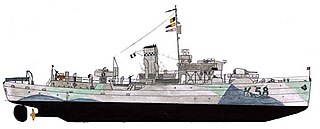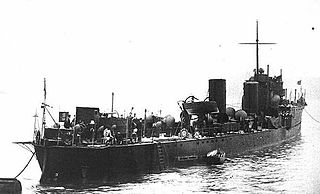Related Research Articles
Eight vessels and one shore station of the Royal Navy were named HMS Grasshopper, named for the grasshopper, a common type of herbivorous insect.
Ten ships of the Royal Navy have been named HMS Lightning.
Seven ships of the Royal Navy have borne the name HMS Niger after the Niger River, whilst another was planned.
HMS Gladiolus was a Flower-class corvette of the Royal Navy, the first ship of her class.
The Royal Navy has four vessels with the name HMS Erne; the name comes from the white-tailed eagle, also known as the erne.
Seven ships of the Royal Navy have been named HMS Hecla, after the volcano Hekla in Iceland.
The first USS McCook (DD-252) was a Clemson-class destroyer in the United States Navy. Entering service in 1919, the ship had a brief active life before being placed in the reserve fleet. Reactivated for World War II, the ship was transferred to the Royal Navy and then to the Royal Canadian Navy and renamed HMCS St. Croix. Assigned as a convoy escort in the Battle of the Atlantic, St. Croix was torpedoed and sunk on 20 September 1943.
Eight vessels of the Royal Navy have been named HMS Acheron after Acheron, a river of Hades in Greek mythology.

Aconit was one of the nine Flower-class corvettes lent by the Royal Navy to the Free French Naval Forces. During World War II, she escorted 116 convoys, spending 728 days at sea. She was awarded the Croix de la Libération and the Croix de Guerre 1939–1945, and was cited by the British Admiralty. Following the war she was used as whaling ship for three different companies from 1947 to 1964.
Twelve ships of the Royal Navy have borne the name HMS Mosquito, or the archaic HMS Musquito, after the tropical insect, the Mosquito:

HMS Peony was a Flower-class corvette of the Royal Navy. In 1943 she was transferred to the Royal Hellenic Navy as RHNS Sachtouris, serving throughout World War II and the Greek Civil War. She was returned to the Royal Navy in 1951 and scrapped in April 1952.

HMS Nadder was a River-class frigate of the Royal Navy during the Second World War. She was transferred to the Royal Indian Navy in 1945 and renamed Shamsher.
Three ships of the Royal Navy have been named HMS Arbutus:
HMS Polyanthus was a Flower-class corvette of the Royal Navy. She was launched on 30 November 1940 from Leith Docks on the Firth of Forth, at an estimated cost of £55,000. Polyanthus was sunk by the German submarine U-952 using new German weapons technology on 20 September 1943 about 1,000 miles southwest of Reykjavík during convoy escort duty in the Battle of the North Atlantic.

HMS Itchen was a Laird-type River-class destroyer ordered by the Royal Navy under the 1901–1902 Naval Estimates. Named after the River Itchen in southern England near Southampton, she was the first ship to carry this name in the Royal Navy.
Four ships of the Royal Navy have borne the name HMS Ettrick after the Scottish river, Ettrick Water.
HMS Itchen (K227) was a River-class frigate of the Royal Navy (RN). Itchen was built to the RN's specifications as a Group I River-class frigate. She served in the North Atlantic during World War II.
HMS Tweed (K250) was a River-class frigate of the Royal Navy (RN). Tweed was built to the RN's specifications as a Group I River-class frigate, though Tweed was one of the few powered by a turbine engine. She served in the North Atlantic during World War II.
References
- Colledge, J. J.; Warlow, Ben (2006) [1969]. Ships of the Royal Navy: The Complete Record of all Fighting Ships of the Royal Navy (Rev. ed.). London: Chatham Publishing. ISBN 978-1-86176-281-8.
- Helgason, Guðmundur. "WWI U-boats: U 99". German and Austrian U-boats of World War I - Kaiserliche Marine - Uboat.net.